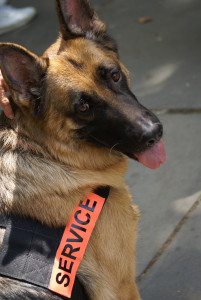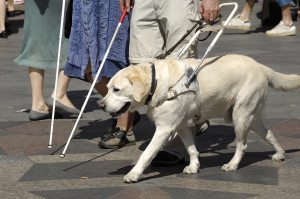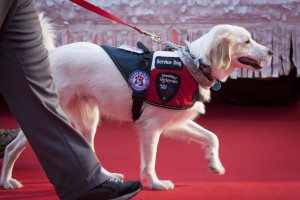Everything you need to know about Service Dogs
This post was guest written by Sally Smith, who is a qualified hearing dog trainer.
A few weeks ago I stumbled across a crowdfunding appeal page. The aim of the page was to fund a service dog for an autistic child. The funding being gathered was a few thousand dollars to buy a specially trained dog for the child, purchased directly from a private company.
Now, as a qualified service dog trainer with a strong charity background this set huge alarm bells jangling in my mind. Wouldn’t attaching a huge payment to a dog of this type create at least a small conflict of interest? Service dogs for profit – was this good for everyone involved?
I decided quickly to look deeper into the unmissable explosion of trained and certified service dogs in and beyond the borders of my own geographical area, here are my findings.
What is a Service Dog Anyway?
The first thing I realized was how broad the label has become. Everyone knows about guide dogs, autism awareness dogs are gradually growing in reputation whilst the service dog for physical disability is also becoming better known.
Dogs are currently being trained in the following roles;
• Guide Dogs, for blind and the visually impaired people.
• Hearing Dogs, for deaf and hard of hearing people.
• Service Dogs, for people with other specific disabilities and conditions.
• Mental disability and varying mental illness
All over the United States there are varying organizations which are training the dog to do what he does best, be the friend of a vulnerable human. There are some charities, some dog training companies and people are even training their pets as personal service dogs.
If we disregard where they are trained for a moment, a topic to which we shall return, we can safely state that a service dog is a canine which is in service to a human. A partner in life, much needed assistance from a loyal friend that doesn’t judge.
The Service Dog Role
The service dog role is varied yet it is fundamentally a role of providing physical and/or emotional support.
I recently saw a video of a brave lady filming herself during an episode linked with Asperger’s syndrome. The attack on her mental and emotional state was distressing and it bought tears to my eyes. Yet her dog was there throughout, touching with his paw, patiently bringing her out the other side. It was a perfect testament to the dog’s steadfast loyalty and the capacity for support, innate within the canine species.
Other service dog roles include guide dogs, hearing dogs, and seizure alert dogs, In addition there are disabled assistance dogs for help with physical tasks and even canine companionship for Post-Traumatic Stress Disorder. As the term grows so does the varied role of the service dog.
Service Dog Training
Servic
Training not only includes the task in hand, whether the dog is taught to be on the lookout for chemical changes in the body or to unpack the groceries, it also includes the portrayal of a completely professional image.
In addition to specifically trained dogs it is within the law to train your own service dog. The specific human rights regarding the Americans with Disability Act makes it your right to classify your own specifically trained dog as a service dog, even if you did all of the training yourself. We will talk more about this soon!
Who Monitors the Service Dog Trainers?
Stick with me through the mass of information that I offer here. This is the stuff you really need to know, it will clear the service dog fog.
Assistance Dogs International is an umbrella organization of which monitors the quality of professionally trained service dogs throughout the US. Providers and potential providers apply to join ADI to show that their methods meet very specific high standards of service.
There are currently 92 different service dog providers registered with ADI. In return for their membership they receive ADI accreditation.
Accreditation with Assistance Dogs International is subject to developing and maintaining high standards in all areas of training, caring for and handling assistance dogs. Theirs is an approach of dog welfare alongside client respect. Assistance Dogs International is basically the benchmark for service dog training in the United States.
In addition to guidelines for high standards within the service dog world ADI membership and accreditation is only available to training organizations that operate on a “not for profit” basis which is a truly positive point as it automatically takes cash out of the equation, thus removing any potential for conflict of interest.
Although at the center of the service dog world ADI is not a federal agency, because with regards to training and handling service dogs no such agency exists.
Service Dog Vests
The service dog vest is the label of a perfectly trained dog and in order to maintain the professional image it must remain that way. A service dog is identified by the professional vest worn within the role. This can vary as it’s usually designed by the specific organization based upon their colors and logo.
Any service dog is entitled to wear a service dog vest. In addition the dog will be approved to enter animal free zones under the Americans with Disability Act. The vest will ideally bear the Assistance Dogs International logo as reputable organizations are keen to advertise their link to the quality benchmark of ADI.
The service dog vest is becoming a common sight and a worrying one. A quick internet search offers a “Service Dog kit for $49”. You or I could put a service dog vest on a dog, simply in order to take him shopping. I recently read a blog post written by a lady that did just that.
Talking through the ease of registering her little dog as a trained service dog on the United States Service Dog Registry the contributor to a pet blog shown here http://www.petful.com/service-animal/service-dog-fraud states that it’s simple to pay your fee and register your service dog, getting in return a status and identity to flash towards any store owners that question the presence of a dog in their midst.
A quick look at the website and I am inclined to agree. The United States Service Dog Registry offers free service dog registration and then the option to buy certificates. The website can be seen here: https://www.usservicedogregistry.org
Identity cards and even clothing that offers service dog certification status are available from the above organization yet few questions are asked regarding the dog itself. The registry does state that anyone registering a service dog must be entitled to the use of a dog for disability purpose, as states the ADA itself.
The National Service Animal Registry http://www.nsarco.com offers a similar service to the United States Service Dog Registry. It seems on first inspection a more rigid application process and offers guidelines for a public access test. This includes behavior guidelines for potential service dogs and their handlers. Yet it is still a case of ticking boxes and handing over the cash.
Training Standards and Service Dogs
Standards of training are where we really begin to question service dog certification. By current law the service dog has no specific training standards to meet, which is quite a serious concern because it leaves service dog certification wide open to abuse.
It’s a scary fact that I could order a service dog vest, for the fearful terrier currently sitting at my feet, then take my dog into shops and cafés without training him to behave like a professional. Truth be told, even as a long term dog trainer, the two of us would be in an embarrassing mess in no time at all.
The ease of access to service dog paraphernalia is particularly concerning. This is exactly why service dog trainers and reputable establishments are getting agitated. The concern is that the increasing number of untrained and poorly trained dogs are being squashed into a service dog vest for all of the wrong reasons.
The use of service dog vests in this way undermines the long term training and effort that it takes to create the behavior of a professional service dog. Similarly the genuinely needy, that benefit greatly from the assistance their carefully trained dog, are being increasingly treated with suspicion by the general public and business owners.
Although it is never under dispute how effectively a service dog changes lives, the ethical stance of internet bought service dog status is increasingly in question.
The general public can be shockingly and disappointingly intolerant of both dogs and people with disability as the comments show in this article by the Federal Way Mirror. http://www.federalwaymirror.com/news/147080865.html# . Poorly trained service dogs and fraudsters make life even more difficult for the genuine service dog user and these are people for whom life is difficult enough.
So, with this in mind let’s take a look at the options to a disabled person that genuinely needs and would greatly benefit from an authentic, professional and well-trained service dog.
How to Get a Service Dog
If you are seeking a trained service dog for yourself or one of your loved ones then you have a number of options. Take a look:
• Approach a local ADI registered service provider in your area and apply for a trained dog.
• Approach a private company that train dogs for profit.
• Find a dog that is suitable and carry out your own training program, with or without professional assistance.
Let’s look in more detail at each of these options.
Finding an ADI Registered ‘Not for Profit’ Service Dog Provider
As I mentioned there are 92 providers registered and committed to meeting the high standards of the ADI organization. There is a handy search facility on the ADI website to find one in your area.
The provider that you approach may have a waiting list. This is part of the reason that so many private companies have been founded but is certainly no good reason to spend thousands of dollars on a dog.
Examples of accredited organizations:
• Autism Dog services in Canada, a program that provides specially trained dogs for children living with conditions on the Autism spectrum. http://www.autismdogservices.ca
• Canine Companions for Independence in Santa Rosa, providing specifically trained dogs for people suffering with disability, with an aim of improving personal independence for recipients. http://www.cci.org
• Assistance Dogs of the West, supplying dogs for many types of need inclusive but not exclusive of challenges caused by multiple sclerosis, cerebral palsy, accidents, traumatic brain injuries and combat injuries. http://assistancedogsofthewest.org
A positive point to this approach is the aftercare involved. The accredited provider will usually have after placement support for the lifetime of the partnership.
I believe that eventually every assistance dog provider will need to meet certain standards by law. In my opinion, someday soon, an organization will be formed or appointed to oversee the training and use of dogs in service dog roles. It may well be Assistance Dogs International.
A Private Company
With this topic we seem to have gone full circle. There are private companies out there which do an exceptional job training service dogs. The important thing to do, if you take this option, is to ensure you work with an ethically driven, client and dog friendly establishment.
The difference between the private company and a not for profit is that the private organization will fund itself and then usually turn over some sort of profit too. This is why we see advertisements that state a fully trained service dog is available at the cost of $7000 or similar amounts.
If you decide that this is the approach you would like to take, I stress that you research the company carefully. Check for good and bad reviews along with aftercare policies and training methods.
Train Your Own Service Dog
This is most certainly an option for you. Training your dog as a service dog is a choice that many take and that works well for many people.
Whether you carry out a lot of research on the topic or bring in a professional trainer, you can bring your much loved dog to the point where his training meets the highest standard of service dog requirements.
It is important that you take into account everything that we have discussed so far if taking this option. If you train your own service dog you may not be able to get support from an accredited organization. Or, to the contrary, a local establishment may be happy to help. With this in mind if there is a provider in your area it is worth getting in touch and explaining your position.
Service dog requirements within the law are pretty hazy. However it is paramount that if you are going to train your own dog you still meet the standards that ADI have created. This adherence is to both respect other service dog users and create a good image of service dogs in general.
Take a look at the standards below, those in italics are taken from the website of Assistance Dogs International.
Public appropriateness
• Dog is clean, well-groomed and does not have an offensive odor.
• Dog does not urinate or defecate in inappropriate locations.
This area of training is based only in good canine care and hygiene. The dog wearing a service dog vest should be clean, in good condition, parasite free and not be grossly over or underweight.
The idea at this point is to ensure that, when in public, the service dog is unlikely to trigger allergies in those susceptible. Similar cleanliness should extend to toileting.
Behavior
• Dog does not solicit attention, visit or annoy any member of the general public.
• Dog does not disrupt the normal course of business.
• Dog does not vocalize unnecessarily, i.e. barking, growling or whining.
• Dog shows no aggression towards people or other animals.
• Dog does not solicit or steal food or other items from the general public.
This area of service dog training standards covers basic social manners and generally acceptable social behavior. A lot of people love dogs and the presence of a service dog will break down social barriers for his recipient in those cases.
There are also a lot of people that avoid dogs and don’t understand the need for service dogs to be in public places. It is for this reason that the dog is trained to quietly fit in with his handler regardless of how populated an area is.
The most successful service dogs and the only dogs which should be awarded full service dog registration are those that can confidently and quietly cope in the public eye. The true service dog is one that sets a good example and that causes no problems for others in public spaces.
Training
• Dog is specifically trained to perform 3 or more tasks to mitigate aspects of the client’s disability.
• Dog works calmly and quietly on harness, leash or other tether.
• Dog is able to perform its tasks in public.
• Dog must be able to lie quietly beside the handler without blocking aisles, doorways, etc.
• Dog is trained to urinate and defecate on command.
• Dog stays within 24″ of its handler at all times unless the nature of a trained task requires it to be working at a greater distance.
If the dog is to be with his owner at all times then he must be well trained. It is important to note that whilst all of the above behavior and training guidelines are not required by law they are in fact, in the majority, common courtesy.
Some dogs are simply not suited to a busy and highly social lifestyle and this too must be taken into account if deciding to train your own service dog.
Many perfectly natured dogs are unsuitable for a service dog lifestyle because they become anxious in new situations, have learned or carry genetic fear responses or simply need a quieter lifestyle than the service dog is allowed.
Within service dog training organizations there is usually a list of potential homes kept. The list is potential new homes ready for the dogs which are not suited to continue their training. It is important that you, if planning to train your own service dog, look carefully at your own lifestyle and ask yourself honestly whether the dog would be happy to extend his own in order to parallel yours.
Specific help for disability depends on the condition. This is usually carried out by, or with the help of, qualified dog trainers using positive reinforcement. This approach is particularly relevant for guide dog tasks and owners with other physical disabilities.
Service Dog Summary
I hope you have learned quite a lot from reading this article. It is very easy to get confused on the topic because certified service dogs seem to be everywhere at the moment.
To summarize:
• Under the Americans with Disability Act a disabled person is entitled to enter any area with a service dog if the dog is helping them.
• There is no federal or governing body that ensures a specific standard of training or behavior is adhered to by service dog handlers.
• Service dog equipment can be purchased online, inclusive of an identity card and canine service dog vest. The kit can be used with any dog yet there is no specific confirmation of disability or training undertaken by the dog before purchase. This procedure is open to abuse.
• There are many non-profit organizations which train service dogs in varying roles for people with disabilities. These may have long waiting lists dependent on the geographical area. All non-profit groups strive to be accredited with the organization Assistance Dogs International for high standard dogs, training and general conduct.
• There are private organizations which train and sell service “ready” dogs. These should be approached with care.
• It is possible to train your own dog to the standard and capacity of certified service dog, not all dogs are suitable for the lifestyle and this should be kept in mind. When your dog is trained you can purchase a service dog vest and identity from a suitable supplier.
On a final note I would like to say that service dogs are wonderful and will enhance any human life that they touch. It’s important not to allow those that are taking advantage of the current lack of regulation to change your opinion on the partnership between human and dog which has been going on for thousands of years.




















